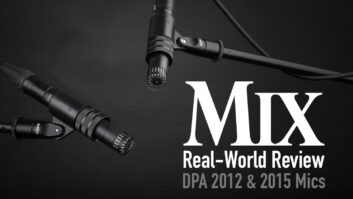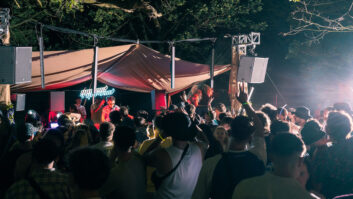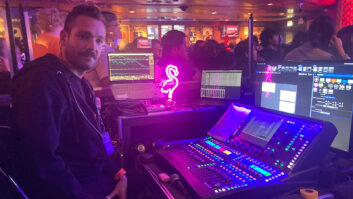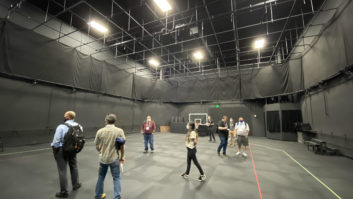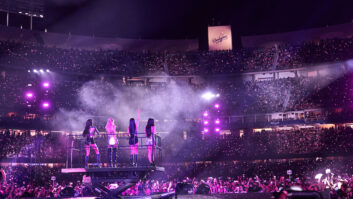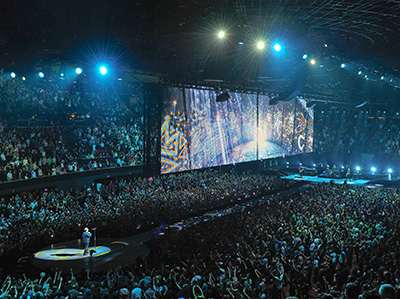
U2 has brought it back inside arenas, playing multiple dates in various cities, again with huge, stellar production values. Mix caught the fourth date of the iNNOCENCE + eXPERIENCE Tour at the SAP Center in San Jose, Calif., where a ramp extended from the main stage all the way down the center of the arena to a circular B-stage, where the band performed several numbers. There’s also a huge LED video wall over the ramp that has a catwalk for the band to perform. Helping to make this all happen is the tour’s show designer, Willie Williams, and Production Manager, Jake Berry. We spoke with the band’s longtime sound engineers about the tour’s audio.

“Jo Ravitch is the best systems engineer there is,” says U2 FOH engineer Joe O’Herlihy. “We have relied on each other for over 30 years now; that is what working together really means. The FOH mix position has been the subject of many a solid debate on this tour because the P.A. system supplies a totally omnipresent sound in the arena—you can realistically put the FOH mix position anywhere. We’re up in the seats this time around, and it’s brilliant being with the audience because they are the people you spend your entire career trying to reach with perfect audio.
“My console is a DiGiCo SD7,” he continues. “It’s extremely creative and reliable, which is why I have used DiGiCo the past 15 years. Across the whole audio team on this tour we are using a total of six SD7 consoles. We’re using all of the available processing power and we are running at 96k. I don’t use any Waves DigiGrid plug-ins. While the onboard dynamic processing on the SD7 is fantastic, I prefer the real deal—lots of vintage processing Manley VOX Box, Avalon 737SP, Summit Audio DCL200s, TC2290 DDL, TC D-TWO, SPX1000, Lexicon 480L, Lexicon PCM 70.”

“The band has been using Clair systems for 30-plus years and for this tour we’re using the new Clair vertical array system called the Cohesion 12,” O’Herlihy explains. “My sound design concept for this tour was based upon our show design brief from the band—that the main stage, the runway stage and the round stage were to be entirely used throughout the show. The P.A. system is typically set up using a stereo image across 12 vertical arrays equidistant from one another, complemented by eight hangs of three Cohesion CP-218 subs using the cardioid method for bass steering into the arena. The P.A. system also incorporates the Cohesion 8, which is distributed as a downfill and center fill system above the front of the main stage, the runway stage and the round stage; we also use the Cohesion 8 as front fill following the same line of the various stages at stage level to maximize the audio quality on the arena floor areas.”

“As I essentially have one mix to focus on, I submix my inputs through stereo audio groups assigned to the center faders to make it feel closer to how I mix in the studio—drums, bass, guitars, etc.,” says monitor engineer Richard Rainey. “I get to spend a lot of time on details that maybe in a traditional setup you wouldn’t be able to. As a lot of Edge’s playing requires very precise timing, the feel of the mix is very important, as is obviously giving him the best timing info I can to play off, which is probably my main focus during the show. After that it’s just turning up the quiet bits and turning down the loud ones till he looks happy.”

The Edge’s vocal headset is a Shure Beta 54. He has two Vox and one Fender Harvard guitar amps miked with Shure Beta 58As, and two Fender Deluxes miked with Shure SM57s.

“Bono uses a standard Shure Beta 58A,” says his monitor engineer, Alastair McMillan. “Then I have an analog chain that goes directly into an SSL X desk to be summed with the SD7 outputs. It’s very clean in that classic SSL way and has loads of headroom, which was an important feature as his vocal is very dynamic. There’s something about his voice that hits the compressors and effects in a unique way. It’s impossible to replicate during setup! So I just have to start with a basic setting and dial it in once he starts singing.”
For in-ear monitors the band is trying something different—the JH Audio JH-16s for everyone except for The Edge and his engineer Richard Rainey, who opted for the JH Roxanne in-ears.

“The DiGiCo SD7 I’m using is extremely powerful and reliable. It can do anything we throw at it,” says Bono monitor engineer Alastair McMillan, pictured at left with monitor engineer CJ Eiriksson (Larry Mullen, Adam Clayton) and monitor engineer Richard Rainey (the Edge), each of whom also has an SD7. “We’re using all of the available processing power, which is quite impressive for a four piece band! I’m a big fan of the new classic EQ option and especially the multiband compressors. With those two features I have everything I need so I decided not to opt for the Waves grid. We’re all running at 96k. I am hooked up to Pro Tools via two Madi bridges which are able to sample convert in real time. This way we can run our Pro Tools sessions at 48k, making them a much more manageable size.”

“We have a fairly traditional mic setup for Larry [Mullen’s] drums, from Shure 421s on toms, to 57s on top and bottom snare, and Audio-Technica 4050s for overheads,” says monitor engineer CJ Eiriksson. “We keep the mics fairly close and tight on everything, which helps keep the arena bleed out of drums as much as possible.

“For this tour Adam [Clayton] has simplified his whole setup,” Eiriksson continues. “We have ditched the bass subs and only have an Ampeg B15 on stage. There are a couple extra DIs and another amp selection running under the stage, but they are only used when needed for different flavors on particular songs.”

